Disclaimer: The information presented below is for general informational & educational purposes only. Always consult with animal professionals in case of specific concerns.
Like humans with distinctive fingerprints, striped and spotted animals are one-of-a-kind due to their pattern.
Interestingly, these species use the stripes for different purposes, apart from distinguishing themselves from others.
In this article, we’ll discuss some animals with stripes and spots from around the world, including some from the water.
Let’s also learn the roles that stripes play.
What Are Animals With Stripes & Spots?
Only a few species have stripes and/or spots on their bodies.
They use their distinctive patterns for different purposes, such as camouflage or temperature regulation.
But do the patterns look the same? When you take a closer look at two tigers, you’ll see that their patterns are all different.
You can spot no two alike because they’re unique as our fingerprints.
Their fur isn’t the only thing with such patterns. You will be surprised to find the same pattern on their skin, almost as if it’s a tattoo.
List Of 14 Animals With Stripes And Spots
You may have seen many striped animals. In this post, we only mention some of the most popular species and discuss their pattern’s characteristics.
Zebra
Zebras are herbivorous animals with patterns. They belong to the Genus Equus Family, including the plains zebra and the mountain zebra.
Because of their white and black stripes, they’re simple to identify. You can quickly find the pattern on the dorsal side of the animal, which extends from its head to tail and other areas of its body.
The markings on the tails, ears, and legs are distinct, and the lines on the lower jaw and eyes, in particular, have intricate patterns.
Its markings have many uses. They may act as protection against the sun and prevent and repel disease-carrying bloodsucking horseflies.

Tiger
The tiger is a big predatory animal of the Felidae family.
It lives in many tropical countries, such as Vietnam, Indonesia, Cambodia, China, Bangladesh, India, Malaysia, Nepal, Myanmar, and Bhutan.
Tigers have brown and white fur with black vertical lines. Each tiger has a different combination of patterns.
These animals with claws have a delicate layer of fur cushioning to warm them up, and their coat is thinner with short hair.
The brown fur and black markings resemble the forest’s pouring sunlight through the branches.
This pattern assists in hiding in the sunlight and the shadows of trees so that the tigers are hard to spot by their prey.

Bongo
The bongo, also known as the Mountain bongo or Lowland bongo, is a herbivorous animal with a nocturnal propensity.
Bongos are the world’s third-largest antelopes, and they have markings on both genders.
They have up to 10 to 15 white markings on their body, on the chestnut-brown coating.
The hair of this animal is short, expanding from its shoulder to its rump. Thanks to the brown coat with white stripes, it can blend well in the background environment.
Okapi
The Okapi, also called the forest giraffe, zebra giraffe, or Congolese giraffe, is a herbivorous mammal living in Africa and other parts of the world. It belongs to the Genus Okapia.
Most people confuse the Okapi for a zebra since its back markings look like those of a Zebra.
Their hair is reddish-brown with white horizontal lines on the back, the legs’ white markings, and the ankles’ white hair.
The combinations of white markings on a brown coat allow for camouflage characteristics in dense foliage.
Some believe that the stripes will aid the young okapis in finding and following their mother through the dense forest.
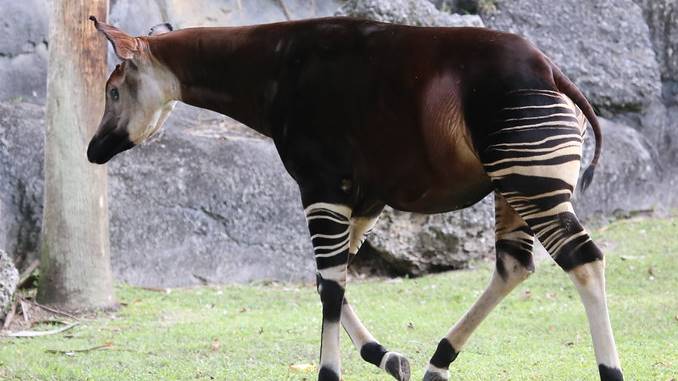
Greater Kudu
This animal is an antelope from the Bovidae family and lives in Southern Africa, Eastern Africa, Ethiopia, and other parts of Africa.
Greater Kudu has a brown-reddish coating with up to 12 vertical white markings running along the middle of its body.
You will also notice darker coats on its head with a tiny white chevron stretching around the eyes.
Surprisingly, the dark coat of this species with white stripes assists it in camouflaging with its surroundings.
Zorse
A zorse is a juvenile horse formed by mating a zebra with another horse in the Genus Equus. You can find this animal in open grassland, African woods, zoos, and other regions.
Based on whether the male is a zebra with a female horse or vice versa, the zorse may have white and striped patterns inherited from its parents.
Zorse has coarse, short fur in various colors, including black, white, brown, tan, red, and gray, as well as some markings on the rump and legs.
Hyena
The striped hyena is a member of the Hyaenidae family that can’t be a good pet to adopt. Its habitats include India, Asia, the Caucasus, and Africa.
They have a filthy gray coat with black vertical stripes and some little spots all over their body.
The fur on its winter coat is thicker and more uniform than on its summer fur. The fur gets softer and denser when winter comes, keeping the animal warm.
Then, when the weather turns hot, the underfur disappears, making a perfect adaptation for hot days.
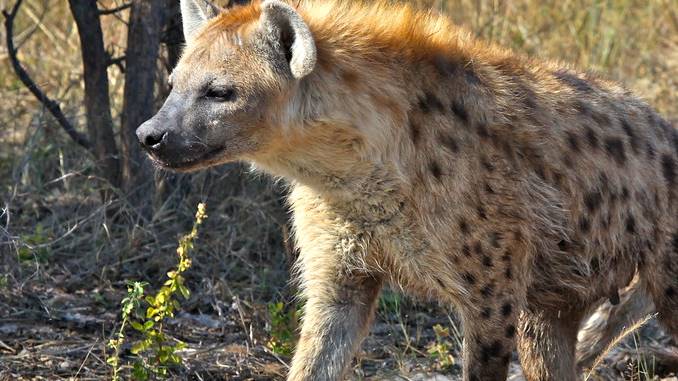
Wild Ass
A member of the Equus family has stripes on its body, and that is a wild ass. These animals live in Ethiopia, Somalia, Africa, and Eritrea.
The wild ass has light-brown fur with black horizontal stripes all over its limbs and body. You can also find a fur stripe running over its shoulder.
The horizontal stripes on the legs of this animal are very similar to the ones on a zebra’s legs.
Numbat
The numbat, sometimes called Banded Anteater and Walpurti, is an insectivorous species in Australia.
This species has reddish-brown fur with a black marking that helps them blend in with their surroundings, especially the forest floor.
A line of black fur runs vertically across its upper body, with bright stripes running parallel to it.
These stripes are brighter on the back of the body and gradually fade as they reach the head, eventually vanishing.
Snakes, birds, and other animals have a hard time recognizing numbats because their coats with black markings match the trees and the ground so well.
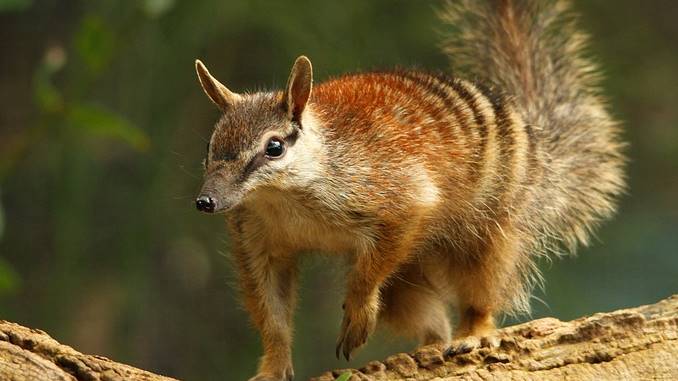
Skunk
A striped skunk is a skunk subspecies found in Canada, Mexico, and North America. It belongs to the Mephitidae family.
The skunks have a black coating with white striped fur on their bodies. The white marking starts from their head and splits into two horizontal stripes that run to their tail.
It’s important to note that this feature may not be available in all skunks. Some of these species have spot patterns instead.
Read more: List Of Animals With Fur And Hair (With Pictures)
Juvenile Tapir
A tapir, or mountain tapir, is a herbivorous mammal seen in America, Mexico, Brazil, Southeast Asia, Paraguay, Thailand, Malaya, and Sumatra. It’s a member of the Tapiridae family.
Mature tapirs have a reddish-brown coating with short fur but no stripe pattern. If there is a stripe, it must be small.
However, when the tapir is still young, you can easily see the markings.
The juvenile tapir has a brown coating all over its body with a white stripe running horizontally. There are some white spots too.
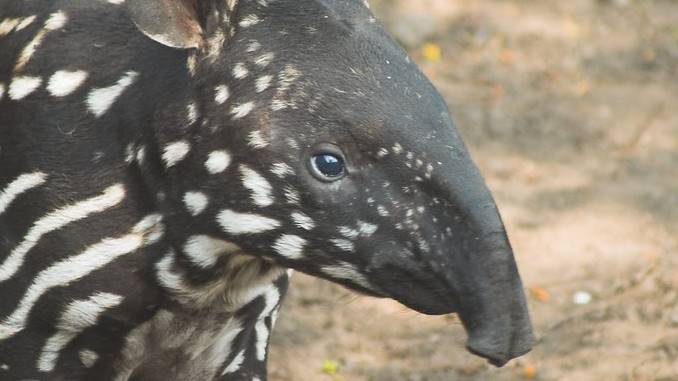
Aardwolf
Aardwolves are nocturnal mammals that belong to the Hyaenidae family and live in Africa and some other parts of the world.
The aardwolf is a tiny animal with a brown-yellowish coating and black stripes running vertically.
On the backside and lateral surfaces of the body, around five to seven black stripes expand to cover the legs.
Eastern Chipmunk
The eastern chipmunk is a subspecies of chipmunk found in North America, Mexico, and Canada.
The reddish-brown fur covers its upper body while the light fur coats the lower part.
There are around five brown horizontal stripes on the back that cross with light brown lines, all of which end at the chipmunk’s tail.
Although the chipmunk looks like a squirrel, it is not one since most squirrels do not have stripes.
Squirrel stripes, if available, are insignificant in comparison to chipmunk patterns in terms of numbers.
Related: Do Chipmunks Make Good Pets?
Clownfish
The clownfish, a member of the Pomacentridae family, is a colorful species in the Pacific Oceans, Red Sea, lagoons, and around anemones.
The fish are orange-reddish with three noticeable white vertical stripes running through them.
The positions of the three stripes are: near the eyes, in the middle, and at the tail.
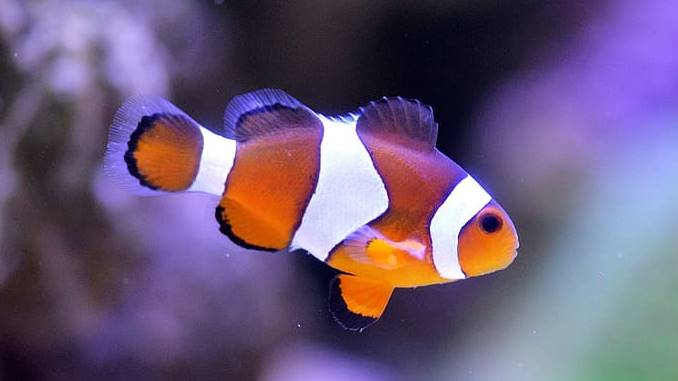
Why Do Some Animals Have Stripes?
As aforementioned, the stripe patterns can not only help distinguish the animals but also serve other purposes, such as:
Camouflage
Can the stripe patterns help camouflage an animal from its predators? Absolutely yes, especially when it chooses the right environment to blend in and stay still there.
Many predators, such as lions, are color blind. If a zebra stands in light-colored tall grass or under a tree, the lion can’t see its prey.
The zebra can take advantage of this feature perfectly when it’s nighttime and in the forest, when seeing things is hard.
Recognition
Because each animal in a group has its own distinct stripe pattern, one idea proposes that their patterns act as unique identification, allowing individuals to be recognizable easily.
Fly bites
Some people believe that stripped animals have such patterns to help them escape attacks from disease-carrying insects. This idea has been around for decades and has gained popularity in recent years.
Having a pattern that boosted defense from biting flies like tsetse flies might be a significant evolutionary benefit.
Biologists researched horses and zebras with different coats, including all-white, black, and white-and-black zebra patterns.
The study discovered that zebras attracted much fewer biting flies than horses.
Horses costumed like zebras caught far fewer insects than horses with no coat, an all-black coat, or an all-white coat.
Temperature regulation
People thought that black markings would absorb heat and warm the animals, whereas white ones would reflect light and keep the zebras cool when grazing in the hot sun.
According to recent research, zebras’ black markings were regularly 50 to 60°F warmer than white stripes.
According to the researchers, this constant temperature differential between stripes would cause mild air to flow over the animal’s back, cooling it.
Frequently Asked Questions
Here are some frequently asked questions about striped animals:
Why do tigers have stripes?
The patterns help this animal blend in with tall grasses and trees by breaking up its form and size.
This characteristic is crucial since these predators do not hunt in packs or run as fast as a cheetah. Tigers are lone cats who live by using camouflage and stealth.
Even the stripes of the six different tiger subspecies vary. The Sumatran has thinner and more markings than the others, helping with its camouflage in its thick forest habitat.
Are zebras white with black stripes or vice versa?
Zebras are black with white markings. The embryo starts off black as it grows in the uterus.
Then, the genes that determine the dark melanin are inactive for the hair follicles that coat particular skin sections, resulting in white markings.
Do all zebras have stripes?
Yes, but it’s worth mentioning the quagga, which has a front half with zebra-like markings and a back half with no marking.
The quagga is a subspecies of the zebra native to South Africa until European colonists killed it to extinction at the end of the 19th century.
Do skunks have stripes or spots?
Both may be correct because there are striped skunks and spotted skunks. The striped skunks have two different stripes on their back.
On the other hand, although the spots aren’t spots, the spotted skunks get their name from the white-and-black patches on their body.
This video shows you more about the differences between striped vs. spotted skunks:
Conclusion
Not many animals have distinctive markings on their body. It’s fun and beneficial to study them. Then, you will have a deeper understanding of the anima world.
Hopefully, you will find this article helpful. If you need any further information, please feel free to ask. Thank you for reading.

Hi, my name is John, and I’m an animal lover. I’ve been fascinated with the animal kingdom since I was 5 years old, and my passion keeps growing bigger as I age. And this blog is where I share my researches and passion with animal lovers all around the world.
